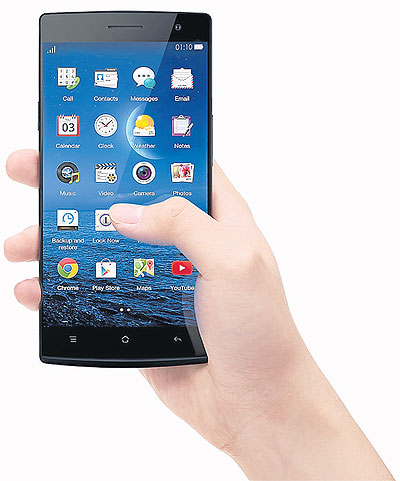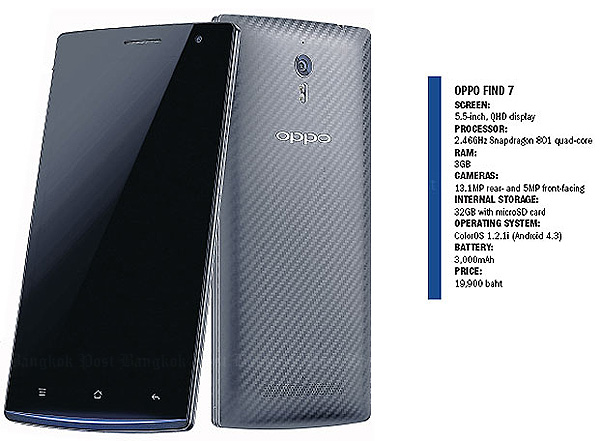
Oppo Find 7 is creating a buzz with its premium specs, usability
Smartphones usually run out of battery before the end of the day regardless of whether they have a power-saving mode. Oppo Find 7, a new flagship model from the Chinese phone-maker, arrives with a rapid-charge feature, and the flat battery problem may now have a quick fix.
Oppo’s Find 7 packs 2560x1440 (QHD) resolution into a 5.5-inch screen. If you do the maths, the screen shows 80% more pixels than your HDTV, giving it the pixel-density crown (538 pixels per inch) and leaving others including the iPhone 5S or HTC M8 in the dust. This is one of the first phones to come with this hi-end technology.
With an overkill QHD display, it needs powerful specs to handle it. The 2.5GHz Snapdragon with 3GB of RAM is in charge. With a Geekbench score of 3,034 and Antutu of 37,244 (faster than a Samsung S5), performance isn’t what it lacks. Loading, switching and closing applications happens instantly.
The 13MP rear camera from Sony captures fine details when used in daylight, but not so well in low-light situations — the noise and blurring is noticeable. The workaround is to use an UltraHD 50MP photo mode. The UltraHD mode combines four photos together, so you will get high-quality snaps in detail. I couldn’t find any practical use for 50MP photos though.
For selfie lovers, the 5MP front camera has a “beautify” feature. You can look “super cute” with only one tap, and you could get more Likes on Facebook, too.
The 23GB user accessible storage is enough to hold hi-res photos, movies and games. But eventually you will need more space and when the time comes, you can expand up to 128GB via the microSD slot.
Battery-hungry specs are every mobile device’s nightmare. While a removable 3,000mAh battery sounds generous, all the high-end specs will quickly draw power. The Oppo’s rapid charge gives us a way to avoid that.
The Find 7’s charger supplies 4.5A output (the average USB port provides 0.5A.), the reason why it charges faster. I charged the battery from 0-34% in 15 minutes. However, the Find 7 must be used with its huge notebook-like charger. Moreover, I tried a 15-minute-charge using a 1A power bank and it gives only 3-4% to the system.

The ColorOS operating system that this phone uses is basically a heavily-customised Android. The reviewed version runs Android 4.3 Jellybean, and there is no word on a 4.4 update yet. However, with its fast user interface and the cuteness of the theme, I fell in love with it.
Speaking of themes, this phone comes equipped with an app that allows to you change the appearance of icons, folders, the app drawer and colours. I spent hours choosing my favourite theme from both pre-loaded and downloadable ones.
There’s a feature that lets you draw simple shapes to launch various tasks or apps. For instance, you can draw a heart shape and the phone will dial your girlfriend, a circle shape to open the camera or V shape to turn on flashlight.
The Oppo Find 7 seems to be a top-notch flagship on paper — it’s got a QHD display, powerful processor and a 13MP camera.
It is, however, marred by some downsides.
First, its QHD resolution looks amazing, but on a screen this size the difference between QHD and 1080p isn’t that noticeable. The hi-resolution screen should be on a 50-inch-plus TV, not a phone.
Secondly, specs this good should use the latest 4.4 KitKat from day one to benefit all features. Even some mid-range smartphones come with Android 4.4 KitKat out of the box. And some of the customised designs like the built-in keyboard layout are difficult to get used to. Lastly, the power button is hard to press. It has to be pressed directly in the centre and with that I often accidentally pushed the screenshot function because the power button is aligned with the lower volume button. The back cover is also hard to remove.
Of course, the Find 7 offers a QHD screen, a super-fast charger and top-of-the-line specs. But the big four (Samsung, HTC, Sony and LG) have already defined the smartphone trend of 2014 and it is now closing the gap — LG G3 offers the same QHD screen. Still, this is the cheapest flagship phone on the market and the powerful specs guarantee its future. It is not easy to overlook the Oppo Find 7.
comments powered by Disqus

